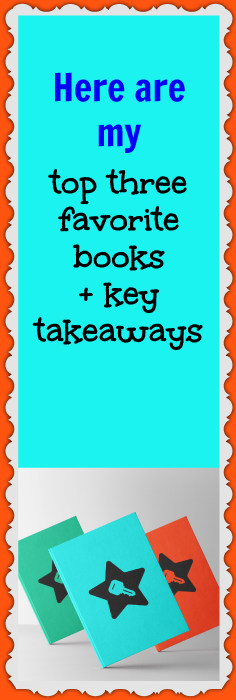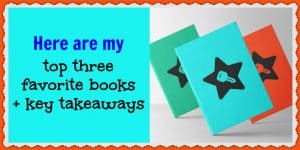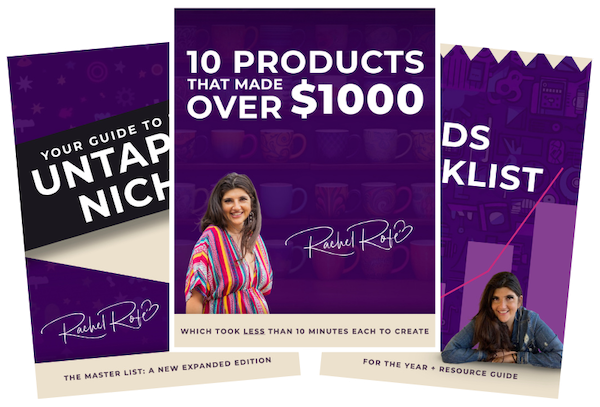I love to read.
Sometimes I read via traditional text, other times I listen to audio. Part of my morning routine is listening to a new book summary from Blinkist (an app that gives 15-minute, “big idea” takeaways from popular self-development or business books) while stretching.
I know this isn’t the same as reading an entire book, but Blinkist does a pretty great job and I love learning new ideas every morning. I also make a note to read full versions of any book that is particularly useful.
My assistant and I were talking about making you a list of some of my favorite books, but I think some of those lists aren’t very useful and are actually just overwhelming – giving you more and more to do.
So instead of giving you a big list, I thought I’d go over my 3 favorite books (plus some honorable mentions), along with some takeaways from them. This way even if you don’t fully read the books, you can learn something from this post.
That said…
Here are my top three favorite books (in no particular order)…
The Slight Edge: Turning Simple Disciplines into Massive Success
By Jeff Olson
I love this book because it makes a very compelling argument on how little actions add up over time.
It talks about how you don’t need to make huge moves in order to “win.” Consistent, small actions add up to excellence, and that is what ultimately makes people successful.
In terms of your business, this could look like making a daily Facebook post, a blog post twice a month, a new design a day… maybe it doesn’t seem like a huge deal at the time, but the compounding effect can be huge.
My mentor said that when Jack Canfield and Mark Victor Hansen were first working on Chicken Soup For The Soul, every day they would take 5 actions towards making their book a bestseller. It worked.
Reading this book was what prompted me to write 5 Minute Morning Boosters, actually.
Another thing I love about the “Slight Edge” philosophy is that doing little things every day versus big pushes once in a while is a lot easier on your nervous system. You feel less stressed and anxious about your work when you’ve done little things every day to pave the way for winning.
Man’s Search For Meaning
By Viktor E. Frankl
This isn’t a business book, although the lessons you learn from it can certainly be applied to your business. More so, though, the book delivers valuable life lessons about the importance of finding meaning and a sense of purpose in your life.
It chronicles the author Viktor Frankl’s experiences in the Auschwitz Nazi concentration camp during World War II when he endured some of the most horrifying things you can possibly imagine.
Frankl persevered and survived these atrocities by using a technique called logotherapy where he chose to focus on a purpose in life versus his immediate terrible circumstances.
To put it in very simplistic terms, he chose a compelling “Why.”
He talks about how important it is for each of us to find our own life’s purpose and sense of meaning, which can vary from person to person.
There is no general meaning of life, he says. Rather, meaning is derived from your unique set of circumstances and decisions. And your success and ability to survive depend on whether or not you’re able to accomplish this perspective shift.
To put it into business terms… maybe you feel frustrated by some annoying bit of technical work. If you shift your perspective and look at how this challenge can help you build an empire, or see it as only a temporary frustration that will eventually help you support the people you love… it can totally erase the immediate feeling of annoyance and help you carry on.
Mindless Eating: Why We Eat More Than We Think
By Brian Wansink, PhD
This book was really interesting for me. It shows all kinds of things we do without thinking about them – mostly via eating, though the same thinking applies to all kinds of things.
It was fascinating to see how many things are done “mindlessly” – especially when those things aren’t necessarily the healthiest.
There are all kinds of cool experiments in it, like:
– The bottomless soup experiment. In this test, people were served soup that kept refilling (via an unseen tube) that they didn’t know about. The test was to see if people would eat more if they didn’t have the visual cue that the bowl was empty. (They ate 73% more).
– The popcorn experiment. In this one, people were given free (stale, 5-day old) popcorn. People were randomly given either a medium or large bucket. Not only did people eat the stale popcorn as much as normal popcorn — but people given the large buckets ate an average of 173 more calories than those with medium (about 53% more dips into the container).
– A wine experiment where wine was given out with fake labels suggesting that it was either from California or from North Dakota. A study showed that restaurant diners drinking the “California” wine rated it – and the food they ate – as tasting better, and ate 11 percent more of their food. They were also more likely to make return reservations.
There were other cool findings too, like showing how much more people eat candy when it’s near them at the office, or graze at the refrigerator, without even thinking about it.
The author says we’re all susceptible to marketing and a lot of our habits are heavily unconsciously influenced. But you can also use those unconscious patterns to eat less.
For example with eating, since people rely on visual cues to decide how much to eat (for example the plate becoming empty), you can serve food on smaller plates or in smaller bags.
Another fix is to keep track of how much you eat during each meal by holding onto some kind of evidence – for example, leftover bones from chicken wings.
There are many business comparisons in this book! For example, it’s very easy to mindlessly go on social media. Putting up things to block yourself, like Self Control App, can help a lot. (And if you’re interested in this kind of thing, you also might like Take Control Of Your Life).
Another business takeaway is that tracking really helps. If it helps, here’s a podcast I’ve done on this before – even though I now track different things. :)
Honorable mentions:
Influence
By Robert B. Cialdini
If you want to learn more about marketing, this book is incredible.
It goes over 6 “influencers” that show why people are persuaded (and how you can persuade – hopefully for good). It’s littered with examples.
The principles are:
– Reciprocity. People are willing to comply with requests (favors, services, etc) from people who provide things first. For example, the American Disabled Veterans organization says that a simple request for donations has an 18% success rate, versus sending out the same request with a small gift of personalized address labels boosts the success rate to 35%.
– Commitment/consistency. If someone takes a step – even a tiny step towards something, it’s much more likely that they’ll continue taking actions towards that commitment. In the book, there’s an example of a restaurant owner with a high amount of people not showing up for their reservations. He reduced the problem by getting a small commitment. Receptionists were trained to stop saying, “Please call if you change your plans” to, “Will you call us if you change your plans?” This dropped the no-show rate from 30% to 10% immediately.
– Authority. People are more willing to listen to people whom they believe has expertise. One study showed pedestrians being 3x as likely to follow someone into traffic against a red light if he were dressed in a suit versus normal clothes.
– Social validation. People are more willing to do things if they see evidence that many others (especially similar to them) are doing it. In the book, a researcher went door to door collecting for charity and carrying a list of others in the area who had already contributed. The longer the list, the more contributions it produced.
– Scarcity. The rarer something is, the more attractive people find it. A beef importer in the US informed his customers (honestly) that weather conditions in Australia would create a shortage of Australian beef. His orders more than doubled. When he added (honestly) that he had an exclusive contact in the Australian National Weather Service, orders increased by 600%.
– Liking/friendship. People prefer to say yes to those they know and like.
Originals: How Non-Conformists Move the World
By Adam Grant
This book challenges some big ideas and is very applicable to the Low Hanging System.
One of the sections it goes into is how quantity and quality of new ideas (and designs) are equally important.
Creative, successful people don’t necessarily come up with better ideas than other people do – they just come up with more ideas, thus increasing their odds of having a few winners.
For example, “Picasso’s entire body of work includes countless rugs and prints, 2,800 ceramics, 1,800 paintings, 1,200 sculptures, and more than 12,000 drawings. And yet. only a small number of these pieces gave Picasso his success and status as an international art icon.”
And even geniuses can’t figure out which one of their works will become timeless classics. Beethoven rated his own work differently than contemporary critics and disagreed with his critics 33% of the time.
There are many other good points to the book, but I thought I’d highlight the LHS one for this.
The Paradox of Choice: Why More Is Less
By Barry Schwartz
This book is fascinating from a marketing standpoint and as a way to better understand people’s decision-making processes.
In today’s society, we have SO many choices. This isn’t always a good thing. Too many choices can lead to negative effects on our psychological well being. Having too many options means it’s harder to make decisions; plus, we become less satisfied with whatever we do choose.
It can actually be a good thing to restrict your options to feel better, because making any decision — no matter how small — typically involves some time, research, and at least a degree of anxiety.
Business-wise, this could mean having fewer offers (NOT for the LHS model, though :)), or giving people more tangible action-oriented information. Actually, the principles behind this book are why we didn’t give you a huge list of books to read but instead whittled the list down and gave you actual takeaways so that even if you didn’t read the books, you’d have gotten something from it and not felt guilty.
The New Psycho-Cybernetics
By Maxwell Matz and Dan S. Kennedy
A few versions of this book are available and I recommend the one featuring Dan Kennedy. The original one is a bit dry.
Generally speaking, the book talks about how if we think of our mental processes as being mechanized, we can overcome our negative thinking patterns and improve the way we view ourselves.
For example, if you want to relax your body and mind and stop micro-analyzing everything, one technique that can help is to create a mental picture of heaviness in your body. Imagine that each of your body parts is made of concrete. And as you begin to sink further down into whatever you are sitting or lying on, you release the tension in your body and mind at the same time.
It also goes into the power of visualizing what you want in the future, and how important that is.
4-Hour Workweek
By Timothy Ferriss
I know this book has been around for awhile and that some of the information is outdated. But after first reading it, my perspective shifted a lot, so this list would feel incomplete if I didn’t at least mention it.
Most people don’t want to feel like they’re trapped in a job, working 9-5, without a lot of time to actually enjoy their lives. As an alternative, creating automated income so you can work fewer hours is a fantastic goal.
To accomplish this, make a few tweaks to your daily routine so you can find more free time for yourself each day.
For starters, don’t check your email first thing in the morning. Email is a “time thief.” Instead, dedicate the morning hours to your most high-level tasks and try to get them done by lunch-time.
12-Week Year
By Brian P. Moran
The general concept in this book is that it’s better to go for 12-week goals instead of 12-year goals. People often wait until the end of the year to reach yearly goals, so going for 12-week goals means you’ll theoretically get 4x as many goals met.
From there, it goes into creating weekly action plans, measuring your execution regularly, and focusing on your goals.
It isn’t necessarily groundbreaking, but it’s extremely helpful when implemented. I’ve used it and have loved it.
Bonus: If you’re looking for another book to read, I recently launched my latest book Don’t Get Sucked In To Bad News. If you’ve been feeling stressed at all by what you’ve been seeing in the news lately, this book is a quick read that I think can really help a lot.
You can also check out my other books here.





